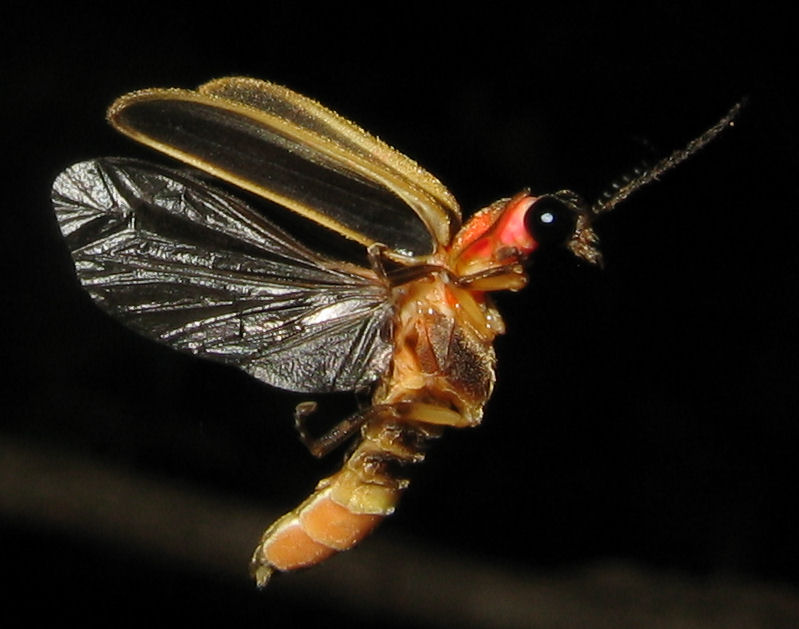Fireflies are the star of the insect world. Here in the Midwest (southern Indiana), they are familiar and common. Kids are fascinated by them. Watching them in the early evening flash in the fields and woods, it seems like they are part of the best days of summer.
With a modest digital camera, you can take great pictures of them in mid-flight. You need a camera capable of all manual controls. These pictures were taken with a Canon A-series retailing today for less than $200 (in 2007). Its almost as if the camera engineers designed the camera with this application in mind. The camera is just capable of taking these pictures.
Your settings may vary of course. Part of the fun is looking at the pictures on the computer to see what you have, then going back out and making adjustments. It's a great way to learn how to use your camera to take close-up pictures.
Camera Keys:
Manual focus, camera flash and settings designed not to overexpose the picture.
These pictures were taken with a fixed focus at 2 inches. You might want to start with 3 inches, it will give you a better chance of success, and you can change to 2 inches as you get the idea. The camera flash is going to freeze the motion. Set the shutter speed to the fastest flash sync. For me that was 1/500 second. Set the aperture to the largest number, f8.0 for me, to get the greatest depth of field. Usually with cheaper cameras at macro distances, the camera flash will overwhelm the subject. The Canon has a simple flash strength in manual mode. Set it to the weakest flash. Similarly, set the ISO number (sensitivity of the "film") to the smallest number (that was 50 for me). The other setting you need to consider is white balance, but it is not so critical. I found slightly better colors by using the "cloudy" setting.
- All manual camera controls
- Focus = 2 inches (try 3 inches to get started)
- Shutter = 1/500
- Aperture = f8.0
- ISO = 50
- Flash = weak
- No shutter lag - half depress button
Picture Technique Keys:
Point the camera with your hands. Don't look thru the viewfinder.
- Tape a piece of thin cardboard, or a string to the bottom of the camera, and cut it off at the focus point. I took pictures of rulers on a tabletop to get just the right length, although for my camera, the minimum focus was exactly two inches from the front of the lens, just as the manual said. Use the guide to train your eye (not to take pictures of fireflies).
- Take practice pictures of non-moving objects at the focus point.
- Hold the camera in both hands
- Point the camera with your hands.
Stalking the Wild Firefly:
- You have to be able to see them against the ground to track them. Be ready for the first ones of the evening. It's too dark when you can only see their flashes.
- Watch the flight pattern. They hover, fly off, flash their light, and hover again. Get ready on their flash, and take on the hover.
- The firefly flies in an inverted hoop, up and over. As he is sinking, he suddenly stops and shoots up. As he shoots up, he flashes his light while moving. Just after flashing his light, he pauses a brief second. He may be looking for a response from his future mate. He seems to tolerate his picture being taken at that moment.
- Track them, bringing the camera closer. Watch a few cycles. Notice the pause which comes right after his flash. During his flash, stay outside his circle of fear (about 6-10 inches), then bring the camera up for a quick no-lag click on his pause.
- The depth of field is not very wide at this range. Most of your best photos with the entire insect in focus will come with the fireflys body parallel to the lens.
- Half-depress the shutter button as soon as you start tracking one. You want no shutter lag to throw off your timing. You don't have time to compose the picture thru the viewfinder, or allow the camera to calculate focus or exposure.
- After you master everything else, the hardest part is bringing the camera up to exactly 2 inches, holding it still, and getting an in-focus shot. But the fireflys come out every night in numbers and you can take a hundred pictures a night. If you get just a few great shots, say 5 or 10 out of 100, you will probably be out there the next evening waiting and and watching the darker areas of your yard, garden or forest for the first golden yellow flash.
It's summer vacation, you can afford to waste time and have some fun.











